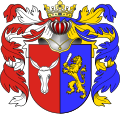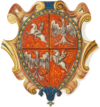Półkozic coat of arms
- View a machine-translated version of the Polish article.
- Machine translation, like DeepL or Google Translate, is a useful starting point for translations, but translators must revise errors as necessary and confirm that the translation is accurate, rather than simply copy-pasting machine-translated text into the English Wikipedia.
- Consider adding a topic to this template: there are already 294 articles in the main category, and specifying
|topic=will aid in categorization. - Do not translate text that appears unreliable or low-quality. If possible, verify the text with references provided in the foreign-language article.
- You must provide copyright attribution in the edit summary accompanying your translation by providing an interlanguage link to the source of your translation. A model attribution edit summary is
Content in this edit is translated from the existing Polish Wikipedia article at [[:pl:Półkozic coat of arms]]; see its history for attribution. - You may also add the template
{{Translated|pl|Półkozic coat of arms}}to the talk page. - For more guidance, see Wikipedia:Translation.
| Półkozic | |
|---|---|
 | |
| Details | |
| Battle cry | Półkoza, Polukoza |
| Alternative names | Osła głowa, Półkoza, Polukozicz, Zebro |
| Earliest mention | 1370 |
| Towns | none |
| Families | 157 names altogether: Biały, Bietkowski, Błazowski, Błażowski, Błędowski, Bobrkowski, Bobryk, Bobrykowicz, Bobrzykiewicz, Bogumiłowicz, Bogumiłowski, Bogusz, Boguszewicz, Bohuszewicz, Borzęcki, Breński, Broniszowski, Brzostowski, Chmielowski, Chorążyc, Czark, Czarkowski, Czarnej, Czarnek, Czarnkowski, Czyżowski, Danielecki, Danikowski, Danilecki, Dankowski, Dańkowski, Dąbkowski, Demczyński, Dłuski, Dobroszewski, Dobryszowski, Dorniak, Garliński, Giebułtowski, Gliwiński, Gostjowski, Gostyjowski, Gradowski, Grodowski, Gronvald, Gronwaldski, Grunwald, Gutowski, Herecki, Horecki, Indyk, Istmont, Jeleniewicz, Jurkowski, Justimont, Justyment, Korkliński, Koszuba, Krzywkowski, Kukwa, Kurdwanowski, Laskowski, Leśnicki, Leśniewicz, Leśniewicz, Leśniowicz, Ligęza, Linksza, Major, Mawolski, Mikołajewski, Minor, Młodecki, Młodnicki, Mołdawski, Mołodawski, Mołodecki, Moszgowy, Nasiełowski, Nasiłowski, Nasiński, Nasiołowski, Niewiarowski, Niewierowicz, Niewierowski, Nikiel, Niwiński, Nowowiejski, Nykiel, Obłąk, Obłąkowski, Obodyński, Pachowski, Pekur, Perakładowski, Perekładowski, Petryk, Piestrzycki, Pikarski, Pikaski, Plichta, Pliszka, Płochut, Pobikrowski, Pogoski, Pohorski, Przemankowski, Przeradowski, Przesławski, Rzeszowski, Sepichowski, Sępichowski, Siestrzeniec, Siostrzeniec, Skotnicki, Sławiec, Smok, Sopichowski, Stamierowski, Stamirowski, Stawisz, Strygocki, Strygucki, Strzygocki, Swenderski, Swęderski, Szczaniecki, Szczekowski, Śwenderski, Świdziński, Świeczka, Świeżyński, Tabor, Taborowicz, Taworowski, Trzewliński, Wąsicki, Wąszycki, Wanatowicz, Wielepnicki, Wielewiejski, Wielowiejski, Wielowieyski, Wilski, Włodek, Wojeński, Wolski, Wrocimowski, Wroćmirowski, Zagwojski, Zalasowski, Zalassowski, Zalaszowski, Zalazowski, Załazowski, Zasada, Zaszada, Ziemblicki, Złotczski, Żenkiewicz |
Półkozic is a Polish coat of arms. It was used by several szlachta families in the times of the Polish–Lithuanian Commonwealth.
History
According to legend, this coat was assigned to knight Stawisz, who was defending the foreign castle of Etecz (or Eczech) against the pagans. When besieged, he ordered to kill a goat and a donkey, and then use their blood to paint ox's hide. With this hide he then ordered to decorate the walls of the castle. The pagans, seeing that defenders had so much meat as to waste it, lifted the siege and left. The knight was rewarded by the king Bolesław I Chrobry with a coat of arms and returned to Poland.
The bearers of the coat were mentioned since early Piast era. Initially they were tied to the land of Lesser Poland, (regions of Sandomierz and Kraków), regions near Lublin, Rawa Mazowiecka, Sieradz and then Red Ruthenia. After the Union of Horodło bearers of the coat of arms appeared also in Lithuania.
Blazon
Gules, donkeys head gardant Argent. Over the helm the crest composed of a goat passant proper Argent.
Notable bearers
Notable bearers of this coat of arms include:
- House of Ligęza
- Jan son of Pakosław (owner of Rzeszów)- a valued diplomat of king Casimir III in many diplomatic missions including mission to pope Urban V
- Marcin of Wrocimowice - Standard-Bearer of the Territory of Kraków in the Battle of Grunwald
- Michał from Czyżowo - member of Royal council of Władysław II Jagiełło.
- The fictional family of Horeszko from the epic poem Pan Tadeusz by Adam Mickiewicz were bearers of Półkozic Coat of Arms.
- Mikołaj Wolski
- Baron Grunwald family, one out of two brothers Ligęza who purchased and owned the Grunwald village Battle of Grunwald where the Battle stand. He liked the village name so much so he changed his name after the village. Standard bearer of own regiment size force at the Battle. The last Baron Grunwald died in Warszawa 1981, ending his House.
Gallery
-
 Coat of Arms of Wladysław Wielowieyski (1825)
Coat of Arms of Wladysław Wielowieyski (1825) -
 Variant Jeski II (1630)
Variant Jeski II (1630) -
 Coat of Arms of Machnicki i Sawnowski family
Coat of Arms of Machnicki i Sawnowski family -
 Coat of Arms of Maskiewicz family (1676)
Coat of Arms of Maskiewicz family (1676) -
 Coat of Arms of Radziejowski family
Coat of Arms of Radziejowski family -
 Coat of Arms of Utratowski family(1662)
Coat of Arms of Utratowski family(1662) -
 Coat of Arms of Justimonti family (1589)
Coat of Arms of Justimonti family (1589)
See also
- Półkozic
- Polish heraldry
- Heraldry
- Coat of Arms
Bibliography
- Alfred Znamierowski: Herbarz rodowy. Warszawa: Świat Książki, 2004, s. 151. ISBN 83-7391-166-9.
- Tadeusz Gajl: Herbarz polski od średniowiecza do XX wieku : ponad 4500 herbów szlacheckich 37 tysięcy nazwisk 55 tysięcy rodów. L&L, 2007. ISBN 978-83-60597-10-1.
External links
- J. Lyčkoŭski. "Belarusian Nobility Coats of Arms". Polkozic Coat of Arms and bearers. (in English)
- pdf ISBN 978-615-80528-1-8 pp. 8-13
- Żenkiewicz
- v
- t
- e
- Abdank
- Abgarowicz
- Achinger
- Aksak
- Alabanda
- Alemani
- Allan
- Amadej
- Antoniewicz
- Azulewicz
- Bajbuza
- Belina
- Bełty
- Bes
- Beztrwogi
- Białynia
- Biberstein
- Bieńkowski
- Biliński
- Bogdanowicz
- Bogorya
- Bogusz
- Bojcza
- Bończa
- Boreyko
- Bożawola
- Brama
- Brochwicz
- Brodzic
- Brzuska
- Casafranca
- Chodkiewicz
- Cholewa
- Chyliński
- Cieleski
- Ciołek
- Czarnowron
- Czartoryski
- Czewoja
- Czewoja II
- Dąb
- Dąbrowa
- Dąbrowski
- Dąbrowski I
- Dębno
- Denhof
- Deszpot
- Dołęga
- Doliwa
- Drogosław
- Druck
- Drużyna
- Dryja
- Działosza
- Finke
- Fleming
- Garczyński
- Gąska
- Geysztor
- Giejsz
- Gierałt
- Ginwiłł
- Glaubicz
- Gliński
- Godziemba
- Goły
- Gozdawa
- Grabie
- Grabowiec
- Groty
- Gryf
- Gryzima
- Grzymała
- Gutak
- Gwiazdy
- Gwiaździcz
- Haller
- Hełm
- Herburt
- Hipocentaur
- Hodyc
- Hornowski
- Hozyusz
- Iwanowski
- Janina
- Jasieńczyk
- Jastrzębiec
- Jelita
- Jeż
- Juńczyk
- Junosza
- Kierdeja
- Kietlicz
- Klamry
- Komar
- Konderski
- Kopacz
- Lew II
- Kopaszyna
- Korab
- Korczak
- Korsak
- Korwin
- Korybut
- Kościesza
- Kot morski
- Kotwica
- Kotwicz
- Kownia
- Kropacz
- Krucina
- Krukowski
- Kryszpin
- Krzywda
- Księżyc
- Kur
- Kur II
- Kurowski
- Kusza
- Łabędź
- Larysza
- Leliwa
- Leszczyc
- Lewart
- Lis
- Łodzia
- Lubicz
- Łuk
- Mądrostki
- Masalski Książę III
- Materna
- Mniszech
- Mogiła
- Mohyła
- Mora
- Nabram
- Nałęcz
- Napiwon
- Nieczuja
- Niesobia
- Nowina
- Nycz
- Odrowąż
- Odwaga
- Odyniec
- Ogończyk
- Oksza
- Orda
- Orla
- Osek
- Ossorya
- Ostoja
- Ostroga
- Ostrogski
- Oszyk
- Paprzyca
- Pierzchała
- Piłsudski
- Piława
- Pobóg
- Pogoń Litewska
- Pogoń Ruska
- Pogonia
- Półkozic
- Pomian
- Poraj
- Pół Orła
- Poronia
- Późniak
- Prawdzic
- Prus
- Prus II Wilczekosy
- Prus III
- Przegonia
- Przerowa
- Przyjaciel
- Przykorwin
- Radwan
- Rawa
- Roch III
- Rogala
- Rola
- Rosyniec
- Rozmiar
- Ryc
- Samson
- Sandrecki
- Sas
- Sas II
- Starykoń
- Sulima
- Szreniawa
- Topór
- Trąby
- Trestka
- Wadwicz
- Waga
- Warnia
- Wąż
- Wczele
- Wejher
- Wieniawa
- Wierzbna
- Wilcza Głowa
- Wysocki
- Wyssogota
- Zabawa
- Zadora
- Zagłoba
- Zaremba
- Zawadzki
- Zerwikaptur
- Zgraja


























